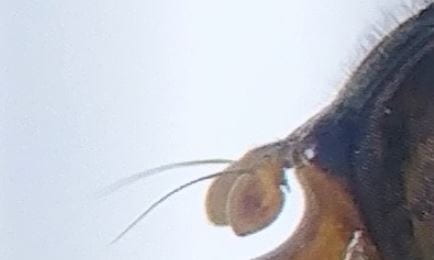We interrupt our regularly scheduled update post to do a guest post by our student worker, Eleanor. She has been working with the hover fly bycatch that also ended up in the bowl traps. The normal weekly updates will be below.
Hello everyone! My name is Eleanor and I’m happy to share some hover fly updates. I’m a student research assistant in the lab and am currently working on a hover fly research project. As mentioned in previous blog posts, the bee bowls trapped a number of other insects, called by-catch. The by-catch included quite a few hover flies, which I’m now using for my project. This will be the first statewide effort to document hoverflies since 1913. We have already pinned over 2,500 hover fly specimens and have identified over 900 at least to the genus level.
Hover flies, also called flower flies or syrphid flies, are a family of flower-visiting flies that have nectar-drinking adults and are considered pollinators of many plant species. The name hover fly was given to them because they’re often seen hovering mid-air. They mimic bees and wasps to ward off predators, and are commonly mistaken for them. However, hover flies don’t sting or bite. It is estimated that over 400 hover fly species are in the Northeastern United States.

Without checking iNaturalist, do you have any guesses what this mystery larvae would be? Grain of rice for scale.
Congrats to Dr. Richard Bradley for guessing the mystery larvae correctly last week – it is indeed a hover fly larva! Hover flies act as both pollinators and predators of other insects. Around one-third of hover fly larvae feed on soft-bodied insects like aphids and thrips which makes them beneficial to have in agricultural areas, where they can act as biological controls and help manage agricultural pests through predation.
If you’d like to see what a hover fly larva looks like when they emerge into an adult, this video is for you!
Being true flies, hover flies possess only one pair of wings, whereas other flying insects possess two pairs of wings. That is one way to quickly determine whether you are looking at a fly or a bee. Hover flies also lack the long antennae that most bees and wasps have. Their antennae are aristate, which means they have three main segments plus a hair on the final segment.
My research objectives are to determine how the landscape affects the abundance and diversity of hoverflies in Ohio. I aim to answer the following questions:
(i) Does hover fly abundance correlate with overall bee abundance? We hypothesize that ecosystems with higher numbers of bees will have higher numbers of hover flies. A correlation between hoverfly abundance and bee abundance would suggest that hoverflies and bees respond to the same kinds of environmental factors, such as flowers and habitat quality.
(ii) How does landscape impact hover fly abundance and species diversity? We hypothesize that urbanization negatively affects hoverfly abundance while factors such as increased forest cover around a collection site will positively affect hoverfly abundance and diversity.
Toxomerus is by far the most abundant genus we’ve collected. Out of 953 specimens, 834 are Toxomerus, which makes up 87% of the identified specimens. The two most common species in the genera are Toxomerus marginatus and Toxomerus geminatus. Eumerus and Paragus are slightly more abundant than the other genera we’ve seen.
When we compare the total number of bees to the total number of hover flies, there is a relationship (as of now) indicating there may be a correlation between hoverfly abundance and bee abundance. This would support our hypothesis that hoverflies and bees respond to the same kinds of environmental factors.
Abundance of hover flies varies by site. Some sites that were sampled have much higher numbers of hover flies than others. As of now, the site with the highest abundance of hover flies is at the Oakwoods Nature Preserve, with a total of 235 specimens collected. It will be interesting to see what the landscape looks like at sites with higher abundances compared to sites that have relatively low abundances of hover flies. The landscape distribution and the impact of landscape on hover fly abundance and diversity will be analyzed by correlating hoverfly abundance and diversity with landscape data from the National Land Cover Database.

The five sites with the most hover flies are listed above. All other sites sorted so far have under 100 hover fly specimens, with an average of only 48 hover flies (and median of only 30 hover flies).
If you’re interested, feel free to listen to a recorded presentation I did on my hover fly research for the 2021 OSU Newark Research Forum. The hover fly presentation starts at 1:23, but there are also several research presentations on covid and molecular research before that.
Link to OSU Newark Research Forum: https://osu.zoom.us/rec/play/U6UL4VgvJ1K45BGUv9M60yGI42L9iAtiT_fIpeLdgp1jiJVIQ2wmCHwwoxBePS031N1yRq7gyy_WuVBf.QePQhZ4BSxXsTT0W?continueMode=true&_x_zm_rtaid=9FLmrU5ZTiuDByIwBnkNqw.1618353519541.84a2d7d1a10124701c7748bdd203876f&_x_zm_rhtaid=68
Relevant hover fly paper: There was a paper published at the end of 2020 that discusses the diversity and floral associations of hover flies in Southern Illinois. Their objectives are similar to ours and their geographic proximity to Ohio provides some insight as to what we might see. See: https://bdj.pensoft.net/article/57331/
Last week we finished sorting 4 kits: K. Thompson (Hardin County), L. Weber (Ashland County), K. Caito (Perry County), C. Margetiak (Huron Co) and started sorting the kit by D. and V. Echternacht (Auglaize County). We are over 22,267 bees pinned and databased. We have sorted at least 50 of the kits, but still plenty of kits left to sort. I was working on project logistics for the specialist bee project, so no new progress on identification.

Thanks to the continued help of more volunteers last week, we were able to keep up our higher rate of pinning!
Helping in the lab in the age of Covid:
We had two volunteers in our lab this week! We greatly appreciate their help processing specimens.
All for now,
MaLisa





Nice job Ellie! Good article.